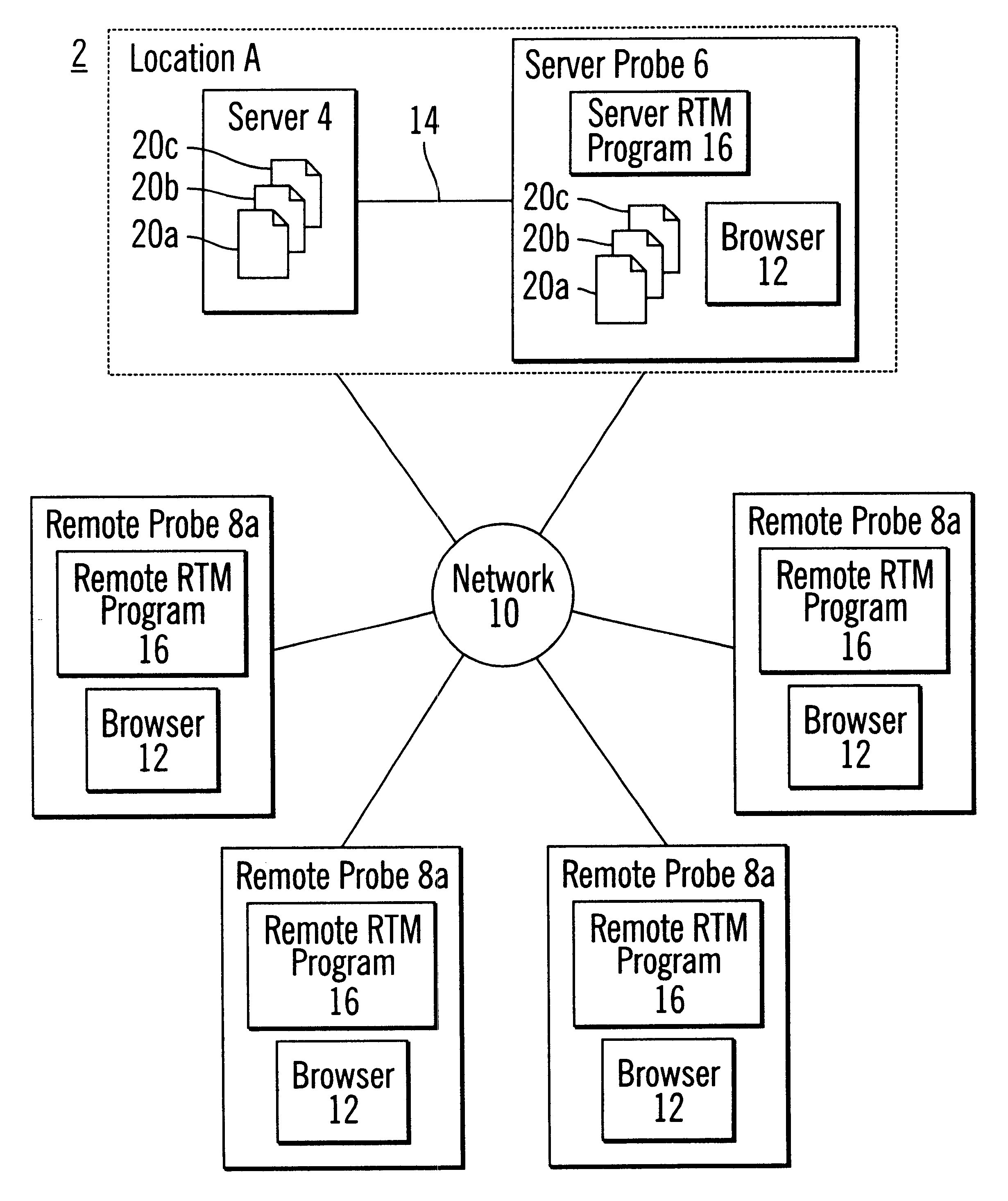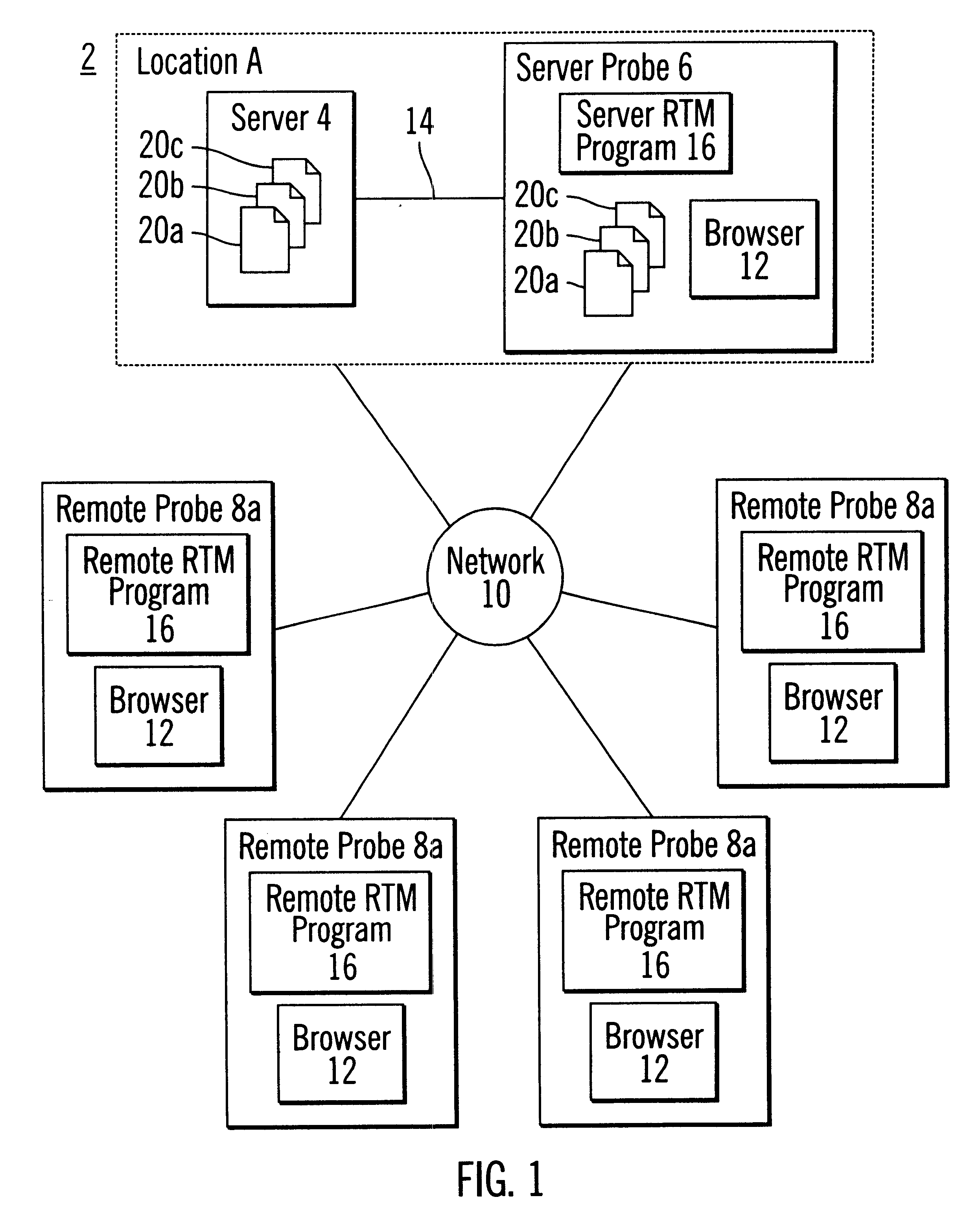In this way, the performance time includes all the
delay time a user, such as a customer, experiences when engaging in transactions with a remote server. With commercial transactions, the performance time can include the time to download a
purchase order from a merchant's server, enter data into the
purchase order, submit the
purchase order to the server, and receive confirmation that the purchase order was processed. Merchants can use actual performance
time information to estimate performance time at IP addresses at any location in the world. These estimated performance times provide an accurate estimate of all delays a
consumer might experience, including network delays and
client performance delays. With this information, a merchant or other
web site host can determine whether the design of their
web site, including the number of pages and content within the pages, produces unacceptable delays in user / customer processing that needs to be addressed in order to avoid losing customers dissatisfied with the delays.
If there are many remote probes, then the performance of the probe that receives the data and its ability to run its own performance tests could be degraded by continually receiving performance data from many probes. In such case, a server computer known in the art may be added which includes a copy of the RTM program 16. All the probes 6, 8a, b, c, d may be configured to send their performance data to the added server.
Data analysis and
performance estimation may then be performed at the added server. The use of the added server insures that the probes' performance and ability to generate performance data that reflects the performance of a common customer or user is not adversely affected by having to receive data from all the other probes and perform
data analysis operations. Still further, the added server may provide a
Web page or other network accessible file that displays or provides in real-time
network performance data from the probes and
performance estimation data.
Preferred embodiments thus allow merchants or other
web site hosts to estimate the time for a hypothetical user or customer at a remote
IP address to download, display the
web page, and perform further precessing, such as submitting a filled in downloaded page to the server to process and provide confirmation. Preferred embodiments allow such estimated wait times to be specific to particular dates and times, geographical area, and page size. In this way, the web site host or merchant can determine
delay times at different times of day, e.g., peak usage hours or off-peak usage hours, at different geographical locations, e.g., Japan, United States, California, Britain, etc., and for different page sizes. Providing an estimate that is based on performance data for a particular web page size incorporates MSSF Page Factor delays in transmitting the web page between the hypothetical user at the
IP address and server. Further, the estimated wait times would incorporate wait times for specific computer systems the user or customer would have because the values in equation (1) that are used to estimate the performance times are based on the hardware and
software configuration of the probes 6, 8a, b, c, d.
Based on the estimated delay times for hypothetical customers at IP addresses around the world, a merchant can then determine whether the estimated network delays are acceptable, i.e., unlikely to discourage users or customers from requesting the pages or performing electronic commerce through the pages. If the delay times are unacceptable, then the web site host or merchant may modify, if necessary, the web pages to reduce the network delays customers around the world would experience when accessing the web pages that comprise the commercial transaction. To minimize delay times, the merchant may reduce the content in the web pages to reduce the size of the pages, thereby reducing delays attributed to the MSSF page factor, or consolidate the content from multiple pages into fewer pages. Alternatively, if the merchant or web site host believes that the
network delay time could be increased without discouraging access, the merchant or host may increase the content and / or number of web pages involved in the transaction to provide more information, additional advertisements or enhance the presentation of the information.
Preferred embodiments discussed the advantages of estimating
network delay times with respect to commercial transactions, such as
purchasing products. However, web site hosts in general would be interested in the preferred embodiment
estimation technique even if users are not purchasing products from the web site host. For instance, many web site hosts, such as newspapers, provide information for free and present advertisements with the free information. Significant network delays for such "free" information could discourage browsing activity at the web site, which would reduce the number of people viewing advertisements and, hence, reduce advertisement revenues. Thus, web site hosts providing advertisements along with free information would want to estimate
network delay times to determine the maximum number of advertisements that may be included on a page and still create acceptable network delay times that would not unduly discourage browsing activities. For such uses, the network
delay time to estimate would include the time for a user to request a page, the server to obtain the requested page and perform any necessary
database searches, the time to transmit the requested information to the user, and the time for the user computer to display the requested information.
 Login to View More
Login to View More  Login to View More
Login to View More 


